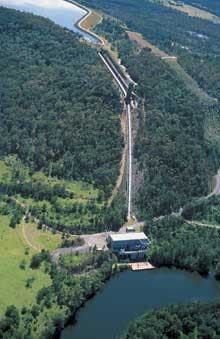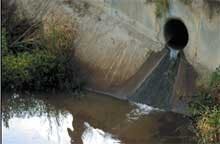By Chris Davis
Australia is trying to change its imported European approach to water management by adapting pragmatically to the country's generally arid and most varying climates in the world. Settlers arriving from England more than 200 years ago found the Australian landscape foreign and not much to their liking, so they adapted it as much as possible to fit the mould to which they were accustomed. Ultimately, Australians are discovering that this approach cannot be sustained much longer.
The combined flow of all Australian rivers is modest by world standards, less than 300,000 Gigalitres per year. Nearly 450 large dams and more than a million small dams were built to cope with a high variability of rainfall and runoff, considered the highest in the world on a par with Southern Africa. Storage volumes in these dams are much higher than for equivalent ones in other climates. The deleterious effect of these dams - reversing flow patterns, discharging cold water and carving up ecosystems — took years to realise.
Australia built a vibrant and successful irrigation industry that generates about 50% of national agricultural production on just 0.5% of its arable land. To turn around and place constraints on that industry, after several generations of encouraging it, is proving to be a serious socio-political challenge. Irrigation-related issues — the impact of forests on runoff, accession to groundwater and evapotranspiration — are all quite profound and have yet to be adequately factored into national strategies.
Australian states and territories bear the responsibility for managing water and the environment, so national policies must be thrashed out among jurisdictional leaders and the prime minister in the Council of Australian Governments (COAG). Cash incentives from the Commonwealth Government are used to sustain the will for reform among those jurisdictions.
Current national policy is to allocate some water to environmental flows in rivers and to sustain aquifers, but this is highly contentious in those basins where some farmers must relinquish a significant proportion of their accustomed water rights. These water rights are a particularly hot topic, since water is vested in the Crown (i.e. the state) and is allocated at the pleasure of the appropriate minister. In New South Wales, for example, profligate issuing of water licences 30 years ago allocated more water than is usually available. A painful process of clawing back some of those rights is now underway. Trading in water is helping the process, but that is a challenging concept for some, raising the spectre of "water barons" who speculate at the expense of farmers.
On the urban scene water issues remain less tense, because the impact of addressing sustainability has yet to affect lifestyle. Most Australian cities and towns are well served by water supplies and sewerage systems, but none has yet seriously addressed the challenge of sustainability; partly because, although sustainability is intuitively an attractive proposition, utilities have not implemented comprehensive measures to achieve this goal. The notions of minimising consump-tion, reusing effluent, creating an integrated water cycle and adopting water-sensitive urban design (WSUD) principles are accepted in Australia, but they are being adopted too slowly. Devices such as front-loading washing machines, efficient showerheads or rainwater tanks are not mandatory. Developers vary in their application of WSUD principles, partly because they receive little tangible support from water utilities to install the system. Consumers are seldom sophisticated enough in their housing purchases to distinguish between sustainable and unsustainable features, so the pace of change is slow, some say glacial.
Fragmentation among utilities, regulators and planning organisations in Australia is a serious hurdle to sustainable changes. Many developers do not accept the premises of integrated water cycle management yet, so these concepts must be promoted to them and to the public. Particularly, the potential to deliver a more sustainable urban fabric at a competitive cost must be effectively demonstrated.
Water conservation remains a challenge. Australia's largest utility, Sydney Water, has a mandatory clause in its operating licence that calls for a 35% reduction in per capita consumption within a decade. Success in moving towards the target has been mixed although education, free retrofits and cash-backs on water efficient devices have all been implemented. The price card cannot easily be played because pricing is the prerogative of the Independent Pricing and Regulatory Tribunal, which tends to adopt an economic and consumer protection stance, rather than an environmental protection agenda. Similar pricing constraints apply in all states and territories, so the prevailing wisdom must start to move before wider acceptance of pricing as a conservation tool will be accepted.
Estimates of effluent reuse vary, but the national figure seems likely to be somewhere in the range from 11% to 14%, higher than most countries, but not as high as it could be. Melbourne Water Corporation set its reuse target at 20%, which is ambitious for a large, coastal city. Among the impediments are, as always, regulatory fragmentation and the absence of clear guidelines for reuse practice. Fear of litigation is a factor in some states where reuse facilities are in place, but bureaucratic hurdles have been erected to delay implementation.
A consensus that sustainable water management is urgently needed is growing; however more Australians are becoming frustrated at the slow pace of implementation. New fault lines are likely to emerge between those ready to move and those impeding necessary changes.
Fortunately, some seminal changes are taking place across Australia. Commonwealth funds from the National Heritage Trust Fund are financing a wide range of innovative demonstration projects, ranging from pervious pavements in a seaside suburb to a high quality reuse system for delivering purified effluent to an oil refinery in Brisbane. The reused water there is considered six-star, according to another Australian
innovation, the star system that rates water quality.
Some of the institutional arrangements being applied and some of the independent assessments being made across New South Wales by the Healthy Rivers Commission are incisive in their assessment and recommendations. The application of cutting-edge technology in wastewater treatment systems to achieve low nutrient discharges and protect receiving waters, is increasingly common across the country. New urban subdivisions with WSUD provisions are really exciting, but uncommon.
The challenge is to shift the balance from a few standout successes to the nationwide application of sustainable principles that are widely understood. A key barrier to their implementation is that policy components, which have been thrashed out among bureaucrats, have not yet been used as bricks in the wall of a visionary national water strategy. This weak point allows vested interests to cry foul when a proposed reform affects their interests; the contribution of the necessary reform has not been correlated explicitly to a national goal reached by consensus.
A crippling drought in place throughout much of 2002 pushed water issues close to the top of the national agenda. Some outlandish proposals, such as turning rivers inland, were made to alleviate the drought, but informed observers are keenly aware that only a long-term, holistic plan will make the difference. Only a nationally debated and widely accepted set of values and goals is going to clear this log-jam, so the sooner it can be developed, the better. Australia's ancient landscape and its 20 million people deserve nothing less.
Author's noteChris Davis is the chief executive officer of the Australian Water Association. For more information, visit the website www.awa.asn.au







